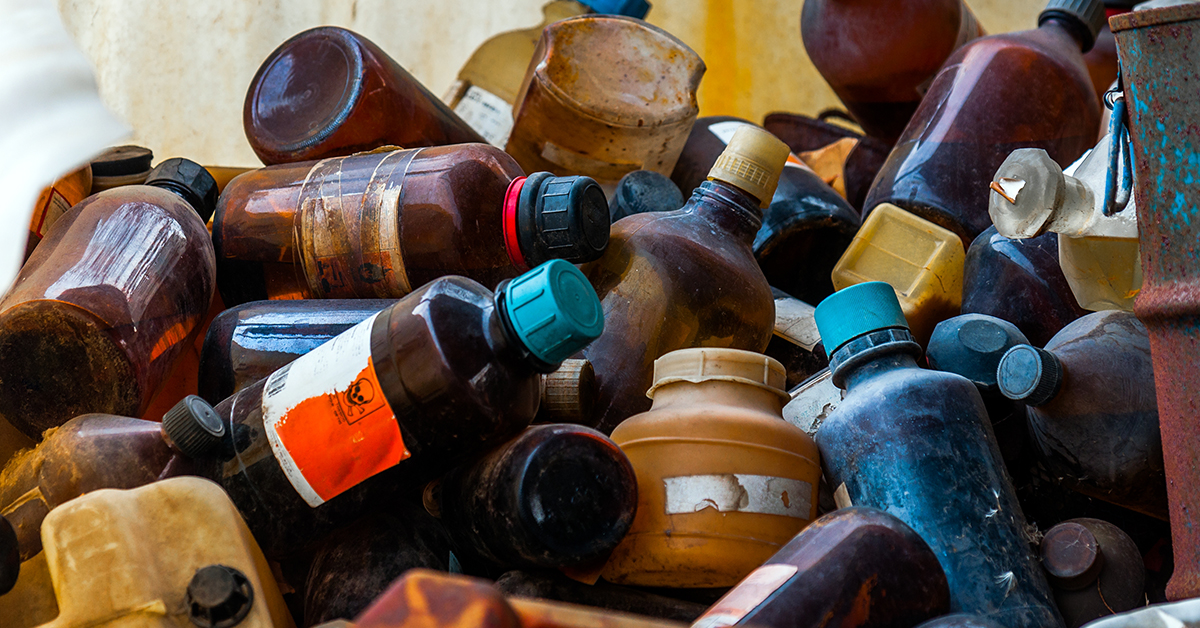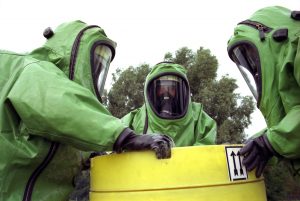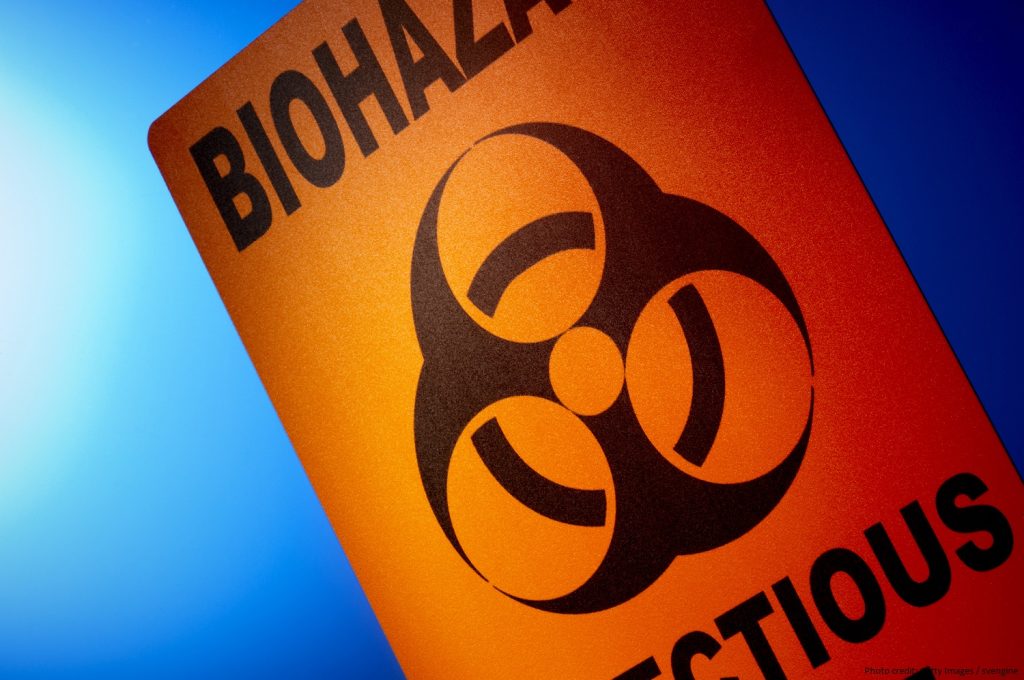by KenBay | Sep 11, 2023

In today’s rapidly evolving industrial landscape, ensuring the safety and well-being of your staff should be a top priority. One crucial aspect of this ever-changing dynamic is creating and maintaining awareness about the proper handling and disposal of hazardous waste. Hazardous waste poses significant risks to human health, the ecological environment, and can result in legal and financial consequences if mishandled. In order to safeguard your employees and your business, it’s essential to establish and promote safety standards in the workplace. This article explores the importance of staff safety awareness regarding hazardous waste and offers guidance on achieving it effectively.
(more…)
by KenBay | Jul 30, 2020

Aerospace Supplier Facility Management
As an industry leading Aerospace Supplier founded in 1979, we have built an excellent reputation within the aerospace sector by providing top notch quality and integrity for almost 40 years. Our philosophy is to provide a superior product by controlling growth and maintaining a sole focus on aerospace. Simply put, we are the “Standard of Excellence” within the aerospace metal finishing industry. Our commitment to the customer, qualified personnel and in-house quality guidelines have made us and will continue to make us a leader within its industry.
(more…)
by Kenbay Admin | Jun 6, 2019

Dealing with hazardous waste disposal can often seem overwhelming.
Not only are there a multitude of hazardous waste disposal rules and regulations to adhere to, but there are also serious consequences associated with any mishap.
The first step in creating a plan to dispose of hazardous waste is to assess your procedures that produce waste and consider how you might diminish their byproducts.
Here are five tips to make sure you’re handling hazardous waste disposal safely and efficiently.
(more…)
by KenBay | Dec 18, 2018
Challenge: Cost of disposing of hazardous waste in tri-wall boxes produced by their paint shop doing repair to aircraft.
Solution: A RotoPacHazPac with its 6 to 1 compaction was installed.
Result: The high compaction reduced the number of tri-wall boxes needed by a factor of 6 and significantly hauling costs producing a savings of $29,000 per year.
by KenBay | Dec 18, 2018
Challenge: They were spending too much time on disposing of masking tape and plastic associated with receiving and painting aircraft in for maintenance and re-finishing. Since these materials are contaminated they had to be packaged in such a way as to meet environmental requirements. They were paying their hauler too much for its deposal.
Solution: Their Quality Control Manager, after doing research contacted KenBay who recommended the RotoPac. Premium is finding that the RotoPac is very effective in accepting and compacting large sheets of plastic along with masking tape into environmentally approved bags.
Result: They average between 600 and 700 lbs. of compacted waste material per bag. Premier found they are paying for the RotoPac in one year from the savings they are accruing from their hauler. They are very pleased with the performance of the RotoPac.
by CharlieB | May 16, 2017
 Got an old painting project that you haven’t done in a while? Maybe some old cans stored up in the garage that you haven’t used yet? What about if you’re involved in the manufacturing industry? Paint is certainly useful, but unused wasteful paint can actually be really harmful. Worse still, disposing of paint can get . . . complicated. So if you have some extra cans lying around, here’s some advice on how to get rid of old paint.
Got an old painting project that you haven’t done in a while? Maybe some old cans stored up in the garage that you haven’t used yet? What about if you’re involved in the manufacturing industry? Paint is certainly useful, but unused wasteful paint can actually be really harmful. Worse still, disposing of paint can get . . . complicated. So if you have some extra cans lying around, here’s some advice on how to get rid of old paint.
For this and other great waste removal tips, rely on KenBay to have the info you need. We commit ourselves to a zero-waste initiative, and encourage other companies to follow suit. visit KenBay’s website today and learn about our wide assortment of compactors available.
How to Get Rid of Old Paint (And Other Safety Tips)
-
Check what kind of paint it is
There’s basically two kinds of paint we’re concerned about: oil and latex. Latex is water based and very safe to store. Most of the paint you encounter for home use is latex based. Oil paint is highly toxic and flammable and should be handled with care. For these tips, we’ll be separating them into oil and latex categories.
-
Oil: Do NOT throw away in the trash
This is important with latex paint as well, but even more so for oil-based: do not just throw it away in the garbage! Oil paint could ignite easily and deal some serious fire damage to whoever is handling it.
-
Oil: Do not store for too long!
Equally as important: while you can store latex paint for a long time, oil paint will eventually reach an expiration limit. Once that occurs, it can emit dangerous toxic fumes.
-
Oil: Take to a proper facility which handles HHW.
Oil paint is classified as a HHW, which stands for Household Hazardous Waste. There are facilities specially handled to dispose of these kinds of materials. Find one in your local area to take your oil-based paint to.
-
Check your drop off-time
While you’re searching for an HHW disposal facility, make sure you check if there are any special regulated drop off or pickup times.
-
Latex: When Possible, Recycle Your Old Paint
Latex paint can be stored for a long time, but don’t let it go to waste on your shelf! It is possible to recycle old paint at special facilities. Find one in your local area! Or repurpose leftover paint for some other project. Perhaps there are some small toys in need a color touch up?
-
Latex: Donate to someone else in need.
If you can’t (or don’t want to) recycle your paint, see if someone else can use it!
-
Latex: If possible, move into a smaller jar or can.
If space is your main concern, it is perfectly fine to move your excess paint into a smaller mason jar or old soup can. Make sure you cover the lid completely with something like saran wrap so that it doesn’t dry.
-
Latex: Turn into a Dry Solid First
If you simply must dispose of your latex paint, don’t make a mess by pouring it into the trash. Instead, harden the paint first. Let it sit outside with the lid open and the sun will take care of the rest. After the paint is hardened, it is perfectly safe to throw out, along with the old can.
-
Latex: Mix with Newspaper or Cat Litter to Speed Dry
For the impatient among us, simply mix the old paint with shredded newspaper, sawdust, or cat litter. The material causes the paint to dry faster, and you will be able to dispose of it quicker.
We hope you found these tips on how to get rid of old paint useful! For non-paint related waste, trust KenBay to have the compactors you need. Our RotoPac can handle any major waste challenge with ease. If you want to experience one for yourself, you can try it before you buy it.
by CharlieB | Apr 15, 2017
 Let’s play a quick game. It’s called “Where Can I Throw Away My Chemical Waste?” Sound like fun? Oh hush, you know it does. So let’s start! So where can you throw away your chemical waste? In the garbage you say? Sorry, that’s the incorrect answer! Down the drain? Wrong again! Throw it out into the street? Are you even trying at this? Okay, okay, we’ll stop messing with you, you probably got our point. Proper chemical disposal is not only an environmental issue, it’s a general safety issue as well. You definitely want to make sure you’re following proper protocol. How do you know you are? Read on and find out.
Let’s play a quick game. It’s called “Where Can I Throw Away My Chemical Waste?” Sound like fun? Oh hush, you know it does. So let’s start! So where can you throw away your chemical waste? In the garbage you say? Sorry, that’s the incorrect answer! Down the drain? Wrong again! Throw it out into the street? Are you even trying at this? Okay, okay, we’ll stop messing with you, you probably got our point. Proper chemical disposal is not only an environmental issue, it’s a general safety issue as well. You definitely want to make sure you’re following proper protocol. How do you know you are? Read on and find out.
KenBay is a company committed to proper disposal of waste, chemical or otherwise. We believe in a zero-waste initiative and encourage other companies to do the same!
Why is Chemical Disposal Important?
Now, we assume if you’re worked in the manufacturing industry for a few years that you understand why proper chemical disposal is critically important. If that’s the case, feel free to skip down to the next paragraph. For everyone else, here’s what you need to know. Improper chemical disposal can have devastating effects on both people and the environment. If you just throw it out with the regular waste, you put sanitation workers at risk. When you flush it down the drain, you send it to a water treatment facility that probably isn’t made to handle it. Finally, if you just throw it outside, you risk causing incredible damage to the local environment. We know you don’t want to do any of these things, so what’s the right way to handle it?
First, Avoid Unsafe Practices
The first thing you need to ensure is that you’re not already disposing of waste improperly, even incidentally. Check through your practices for your workplace, including any chemical labs if that’s necessary. If you uncover any improper chemical disposal in your investigation, shut down that practice immediately.
Second, Conduct Research
The most important thing you can do is keep yourself informed about proper chemical disposal. We wish that it were as easy as saying “put chemicals here!” but that obviously isn’t the case. Different chemicals may require different disposal methods. Not to mention the different federal and state regulations that you also need to comply with. Those, obviously, may change depending on your location. A great resource to turn to is the Environmental Protection Agency website. The EPA is a valuable resource when it comes to waste management of any kind. One of the benefits here is that they offer a comprehensive breakdown of the Resource Conservation and Recovery Act, which covers hazardous waste disposal. If you’re looking to learn more about hazardous waste, this is a great place to start.
Once you’re up to date on your info, it will be easier to implement the state and federal practices to dispose of your chemical waste properly. And for all your waste disposal needs, you can rely on KenBay to help you and keep you informed. KenBay offers a wide assortment of waste compactors, including the HazPac for Hazardous Waste. If you want to experience KenBay for yourself, you can try us before you buy us. See for yourself the difference a good waste compactor can make.
by CharlieB | Dec 21, 2016

The romantic side of me likes to imagine dust as a signifier of age and wisdom. I picture an old dusty library, books brimming with secrets waiting to be imparted. In reality, dust is a big problem for a lot of people. In your home, dust is unsightly. Far from your house appearing mysterious and interesting, you come across more that you don’t know how to take care of yourself. Think about it: have you ever been inside of a dusty room and found it pleasant? The problem is even worse for the manufacturing industry, where dust should not be tolerated whatsoever. KenBay knows that dealing with excess of any kind requires the right tools and the right mindset. You may think you need a dust collector in order to handle this problem — but think again!
Why Dust is a Problem
Dust may not be called “The Silent Killer” — that distinction goes to mold, high blood pressure, and carbon monoxide— but it can still do a lot of damage. On the one hand, there’s the basic issue of cleanliness. After all, nobody wants to work in a dirty environment, and you need to keep your employees happy. But there are deeper concerns at play here. The World Health Organization actually has listed airborne dust as a major workplace hazard because it can lead to disease, disability and even death. “But it’s just dust!” you may say. “I see it all the time! It can’t be that bad.” On the contrary: under the right circumstances, dust inhalation can lead to infertility or even cancer. How can this be?
Dust is composed of micro particles that come off the everyday materials around you. Anything small enough to be broken down into tiny bits and light enough to be tossed about in the air. If you live in a regular household environment, dust is little more than an annoyance. However, in the manufacturing industry, you are surrounded by toxic materials which then contaminate the dust and, subsequently, your lungs. At low exposure, you’re probably safe. The more dust you are exposed to, however, the greater risk you have of serious health complications. The Canadian Centre for Occupational Health and Safety has a comprehensive list of the effects dust has on the body, as well as diseases that dust exposure can lead to. When it comes to your employees, it’s better to be safe than sorry.
Skip the Dust Collector, Find a Better Answer
So what can you do to keep your work environment safe and your employees happy? One easy solution is to acquire a dust collector. We, however, are not quite satisfied with that idea. For one thing, a dust collector is only used after the dust has had time to settle in. For another, you (or one of your employees) will need to spend quite a bit of time cleaning with one to make sure everything is dust free. We believe there is a better way — a KenBay Rotopac! Our RotoPacs are hooded, so the dust never goes into the air in the first place. And they are small enough to be placed at the source of the waste, so everything is more efficient. You get a cleaner environment, no contamination, and safer conditions for your employees. If you are interested in trying out one of KenBay’s RotoPacs for yourself, then you can try it before you buy it through our website!
by LaurenL | Oct 21, 2016
 We know that businesses face a unique set of waste management challenges when they handle hazardous substances. Where others can send their waste to a landfill or Waste to Energy plant without a second thought, these businesses must consider additional steps. Because the responsible disposal of hazardous substances is different than the disposal of other waste products, businesses should have a separate waste management plan for hazardous materials. While daunting, it’s important to consider these processes and look for ways to improve upon them.
We know that businesses face a unique set of waste management challenges when they handle hazardous substances. Where others can send their waste to a landfill or Waste to Energy plant without a second thought, these businesses must consider additional steps. Because the responsible disposal of hazardous substances is different than the disposal of other waste products, businesses should have a separate waste management plan for hazardous materials. While daunting, it’s important to consider these processes and look for ways to improve upon them.
What are Hazardous Substances?
One challenge that manufactures sometimes face is knowing exactly what is considered a hazardous substance. To effectively manage hazardous waste, it is important to know the EPA and OSHA hazardous substance definition. It’s also important to know the state and federal requirements and laws that dictate how hazardous waste must be managed. Some of the most common types of hazardous substances often include:
- Ignitable items that easily catch on fire like solvents, paint, and gasoline
- Corrosive waste that “eats” something else, including battery acid, caustic paint strippers, and some floor cleaners
- Reactive waste that is unstable or explosive like certain cyanide and sulfide-bearing waste
- Toxic substances that are harmful when ingested or absorbed like gasoline and solvents
These are just a few hazardous substances examples. When you look for ways to improve your processes for handling hazardous waste, do thorough research. Look for a hazardous substances list that is specific to your industry, and be sure you understand the legal requirements for disposing of it.
Evaluate Your Process Repeatedly
One of the best ways you can improve your processes for handling hazardous substances is by simply monitoring your processes more often. First, you’ll need to create a plan for handling hazardous waste, using industry, state, and federal guidelines. Then, you need to evaluate that plan repeatedly. To ensure that your system is up-to-date, efficient, and safe, you need to reevaluate your procedures from time to time. At least once every quarter, set aside time to take a look at the waste products in your business. Then, find ways to improve your process.
Handle Hazardous Substances Less Often
It goes without saying that the safest way to handle hazardous substances is to not handle it all. Take a significant step to improving your processes for safely handling hazardous substances by finding ways to handle dangerous waste less often. To do this, consider a small footprint compactor that can be placed at the source of hazardous waste.
Hazardous waste compactors like our HazPac allow you to handle dangerous substances less often. In addition, the HazPac has a small footprint, high compaction rate, ease of use, and a unique ability to compact waste into bulk bags or into hazardous waste boxes. This makes our hazardous waste compactor ideal for compacting hazardous waste for transporting. In addition, because of the HazPac’s small footprint, it can be placed close to the source hazardous material generation, saving travel time and increasing safety and efficiency.
Learn More about KenBay’s Waste Management Products
We know that waste management can be a burden. But, with KenBay, you’ll have the tools you need to help make the job a little easier. The next time you evaluate your waste products and waste management strategy, consider integrating one of our industrial trash compactors into your processes.
Don’t let something like a waste get in the way of your business operations. If you’re interested in trash compactors or finding a committed consultant to help you reduce your waste, call KenBay. We can tell you more about our services, no matter what industry you’re in, or how much waste you are creating!
Photo credit: Getty Images / svengine
by charlotte | May 20, 2016

Paint disposal or storage can be a daunting task whether you’re dealing with a small home supply or an industrial facility with various paints and solvents to consider. With just a few protocols, you can be sure that your paint disposal is always safe and environmentally sound, no matter the quantities you’re handling. Taking care of your paint disposal in the proper way will do more than just ensure the safe handling of hazardous waste, it will also save you money in long run, and reduce risk in either your workplace or home.
Reduce Your Need for Paint Disposal
Whether you’ve recently repainted your house, or work in the autobody business and go through gallons every day, proper paint disposal is equally important to consider. But before you get to that step, there are many measures you can take to reduce the amount of waste you have when the job is done. First, make sure that you can return any unopened paint cans or spray bottles. You will not only get reimbursed and save yourself some money, but it will also ensure that the paint actually gets used instead of thrown away. Safely store some of the leftover paint in a cool dark location for touch ups, and be sure it is tightly sealed. You can even switch it into smaller airtight containers to save space or get a better seal. Properly stored paints and solvents will usually remain safe to use for up to ten years, so give them a permanent home that is out of the reach of the kids. There are also ways of re-tinting paint to use it for new or different purposes than you originally bought it for.
Leftover Paint Disposal
If there is still paint or solvents (often used for cleaning) that you cannot repurpose or save for future use, you will need to find the proper means to dispose of them. These materials are usually considered liquid hazardous waste, so they cannot go in the dumpster. Call your local waste sector to find out how you ought to handle paint disposal, which will typically involve a certain kind of airtight container for paint. It will also have to be kept separate from the rest of your waste and recycling to ensure that contamination does not occur.
Solid Waste in Paint Disposal
A paint can or spray bottle is considered empty if it has less than one inch of paint at the bottom of it. Empty the vessel by either pouring or pumping the paint out of it, and once you have done this, it is considered recyclable, in which case you take the usual measures to separate it out from landfill waste. If paint cans are a significant portion of your waste, you might want to consider investing in a trash compactor that will help you consolidate the otherwise non-pliable materials to save time and money on your recycling efforts. A trash compactor will reduce the size of your waste at a rate of six to one.
When tackling your paint disposal process, keep these things in mind. If you’re dealing with paint disposal on a large scale, call KenBay for an expert opinion on your particular waste management needs.





 Got an old painting project that you haven’t done in a while? Maybe some old cans stored up in the garage that you haven’t used yet? What about if you’re involved in the manufacturing industry? Paint is certainly useful, but unused wasteful paint can actually be really harmful. Worse still, disposing of paint can get . . . complicated. So if you have some extra cans lying around, here’s some advice on how to get rid of old paint.
Got an old painting project that you haven’t done in a while? Maybe some old cans stored up in the garage that you haven’t used yet? What about if you’re involved in the manufacturing industry? Paint is certainly useful, but unused wasteful paint can actually be really harmful. Worse still, disposing of paint can get . . . complicated. So if you have some extra cans lying around, here’s some advice on how to get rid of old paint. Let’s play a quick game. It’s called “Where Can I Throw Away My Chemical Waste?” Sound like fun? Oh hush, you know it does. So let’s start! So where can you throw away your chemical waste? In the garbage you say? Sorry, that’s the incorrect answer! Down the drain? Wrong again! Throw it out into the street? Are you even trying at this? Okay, okay, we’ll stop messing with you, you probably got our point. Proper chemical disposal is not only an environmental issue, it’s a general safety issue as well. You definitely want to make sure you’re following proper protocol. How do you know you are? Read on and find out.
Let’s play a quick game. It’s called “Where Can I Throw Away My Chemical Waste?” Sound like fun? Oh hush, you know it does. So let’s start! So where can you throw away your chemical waste? In the garbage you say? Sorry, that’s the incorrect answer! Down the drain? Wrong again! Throw it out into the street? Are you even trying at this? Okay, okay, we’ll stop messing with you, you probably got our point. Proper chemical disposal is not only an environmental issue, it’s a general safety issue as well. You definitely want to make sure you’re following proper protocol. How do you know you are? Read on and find out.
 We know that businesses face a unique set of waste management challenges when they handle hazardous substances. Where others can send their waste to a landfill or Waste to Energy plant without a second thought, these businesses must consider additional steps. Because the responsible disposal of hazardous substances is different than the disposal of other waste products, businesses should have a separate waste management plan for hazardous materials. While daunting, it’s important to consider these processes and look for ways to improve upon them.
We know that businesses face a unique set of waste management challenges when they handle hazardous substances. Where others can send their waste to a landfill or Waste to Energy plant without a second thought, these businesses must consider additional steps. Because the responsible disposal of hazardous substances is different than the disposal of other waste products, businesses should have a separate waste management plan for hazardous materials. While daunting, it’s important to consider these processes and look for ways to improve upon them. 
